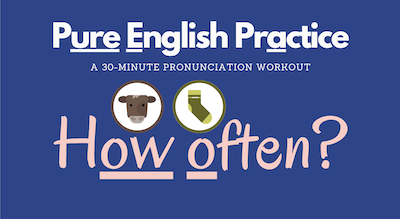Pure English Practice is never perfect, but that's okay.
I teach a free online pronunciation class twice per month called Pure English Practice. What I love about this class is that it's attracts both English learners and English teachers. Think of it as a lab class that teachers can observe any time without advance notice. Where else can you do that?
Of course, doing a drop-in observation means that you'll see my own real teaching: the good, the bad, and the ugly, as the saying goes. I of course aim for the 'good', but for me, it's all part of walking the walk of the Color Vowel® Approach: aiming to talk less, model more, listen with knowledge, and respond with feedback that is concise, useful, accessible, and humanistic.
How can I possibly train teachers in these ideals without putting them into practice myself? After all, these are ideals, and none of us is perfect.
Needless to say, Pure English Practice keeps me on my toes. I never know who's going to attend. Sometimes, teachers bring their students as part of a virtual field trip. Other times, I might find myself with a handful of English learners I've never seen before. L1 (first language) backgrounds always vary, and so do their levels of English proficiency. Some have emigrated to the US; others are doing self-study in their country. They're Colombians living in Australia. They're Romanian nuns. They're Vietnamese influencers traveling the world. They're anyone and everyone.
Whatever the mix, I aim to deliver what they've come for: an opportunity to listen and speak with strategies that integrate their mind and their body. An opportunity to notice and walk away with a new awareness of how spoken English works.
All ideals aside, though, I had a rough session a couple of weeks ago. (And no, I didn't post the recording on our PEP YouTube Channel. I do have standards, after all.) There were about eight participants, but six of them kept themselves blackboxed - no video, no audio. That left me with two participants, both first-timers, and that's fine. I can work with two people or two hundred people.
But this time I got rattled. The two visible participants were lovely, but I kept looking at the blackboxed people. I did that weird thing teachers do sometimes: I kept wondering who they were, why they were here, what they were thinking. I started doubting my purpose.
So guess what I did? In an effort to fill the void I perceived, I talked. And explained. And gave examples. And talked some more. Worst of all, no one left the room. They just stayed and listened... quietly. And the quieter they were, the more I did what I passionately aim to train teachers out of doing: blah. blah. blah.
In other words, it wasn't the learners who made the lesson rocky -- that was all me.
I talked with my friend Laura after the session. I told her how annoyed I was at myself and how I'd tricked myself to focus on the blackboxed people. She kindly reminded me, "The best part of Pure English Practice is the practice -- so just do that!" She was right, of course.
With renewed clarity, I recommitted myself to delivering the "pure" part of Pure English Practice. We warmed up. We did a chant. They practiced. We engaged in another chant. And they engaged.
The result was satisfying. Not perfect, but definitely productive. Learners asked good questions, and they practiced with the answers. Their responses were proof that I'd managed to take us to that special place where spoken English is inviting, flexible and attainable. And that's good enough for me. That's good enough for now.

